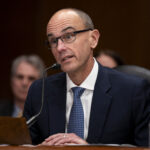The next three years will be critical to the long-term growth prospects of the cyber insurance market, according to a scenario-led analysis of the market’s dynamics report released by Conning, “Cyber Risk: On the Edge of Insurability.”
Conning projects the cyber market will continue to grow at double-digit rates driven by strong new business opportunities, both in the U.S. and internationally, in the absence of near-term exceptional catastrophe losses.
As the cyber market continues to experience rapid growth, so too will the ability to absorb future catastrophe losses.
Under a different scenario, Conning found that a still immature cyber market could be rocked by one or more near-term catastrophe events on a scale not previously seen.
This alternate scenario could lead to reduced confidence in available cyber risk models and “deter investors from committing capital to the nascent cyber catastrophe bond market,” the report noted.
If this were to occur, the Conning analysis found it could lead to three potential consequences:
- In the absence of a large and liquid market for tail risk, the overall cyber market would lack the capacity needed to meet continued demand at affordable prices.
- Prices would rise sharply, to the point where self-insurance becomes more attractive to buyers.
- Pressure grows for taxpayer financed risk transfer options.
The study explores a range of variables leading to the above scenarios, including the drivers of demand for coverage in the U.S. and internationally, and among companies of different sizes; the diverse perils commonly classed as cyber risk and the benefits of bundling or unbundling them; the reliability of current cyber catastrophe models relative to the natural catastrophe models that have supported the steady growth of the insurance linked securities (ILS) market for natural catastrophe risks; and the advantages and disadvantages of “policy tooling” to manage exposures — like the insertion of policy exclusions for systemic risks such as war (broadly defined) and critical infrastructure failure.
The study draws upon a wide range of data sources, supplemented by interviews with many of the cyber market’s most experienced underwriters and brokers.
“Cyber has grown faster than any other line of business in recent years,” notes William Pitt, a director at Conning and author of the cyber insurance study. “But it is still a small and immature market. The growth opportunity remains unrivaled, but investor confidence and carriers’ risk appetites are both fragile. Given this, the scale and imminence of catastrophe losses could permanently affect the market’s growth trajectory.”





















 Why Insurance Telematics Integrations Fail
Why Insurance Telematics Integrations Fail  Rebuilding Negotiation Talent: Why This Skill Is Missing and How to Fix It
Rebuilding Negotiation Talent: Why This Skill Is Missing and How to Fix It  McKinsey Plots Thousands of Job Cuts in Slowdown for Consulting Industry
McKinsey Plots Thousands of Job Cuts in Slowdown for Consulting Industry  Legal Finance and Insurance: From Confusion to Collaboration
Legal Finance and Insurance: From Confusion to Collaboration 